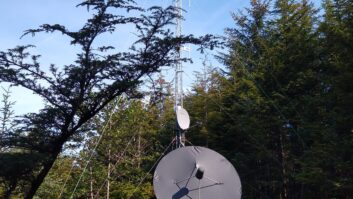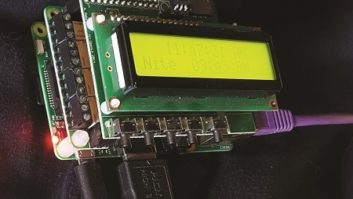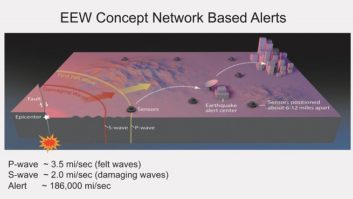(click thumbnail)Fig. 1: Joe Stack’s simple schematic for getting audio into and out of a cell phone.Are you looking for a low-cost interface to be able to send and receive audio from a cell phone? The circuit shown in Fig. 1 designed by Joe Stack will get the job done. Joe used RCAs for the “ins and outs” and shielded cable throughout the mic circuit.
The circuit is simple and there is room to move on the component values, so this should be easy to build in the field. The completed board is shown in Fig. 2.
(click thumbnail)Fig. 2: Components mount easily on a board inside a project box.In keeping with the simplicity theme, Joe cut a square hole in the box lid; that way your fingers can reach the audio adjustment pots. The potentiometers are mounted on the circuit board, and the knurled edges just rise above the level of the box top for easy adjustment, as seen in Fig. 3.
* * *
Gregory Muir is the chief engineer for Cherry Creek Radio and Central Montana Radio Network. Greg writes that while pursuing one of his more boring tasks attempting to find a good source of rack clip nuts, he found www.rackrelease.com.
This site offers an interesting assortment of not only the plain vanilla screw and nut assortments, but also some variants to include “quick-release” and thumbscrew-style rack screws. Visit the site and be amazed at the world of rack screws.
(click thumbnail)Fig. 3: A hole cut in the box lid permits easy potentiometer adjustment.
Thanks, Greg, for a great place to bookmark.
* * *
With fall comes the nesting instinct of both animals and insects, seeking a way out of the cold.
Warm transmitter buildings are a draw, so ensure that cracks and openings are sealed; this is good insurance against pests that could ruin a site. Expanding foam coupled with stainless steel wool (found at Dollar Store-style retailers, in the kitchen supply area) make a better barrier than the foam by itself, when filling large spaces.
Mothballs sprinkled on the building floor and inside the bottom of equipment racks will deter snakes.
With inclement weather comes the possibility of being stranded at a transmitter site. Spend a few minutes putting together a survival kit of granola bars, bottled water and perhaps a heat-reflecting space blanket in a sealed plastic container. Just in case.
* * *
Radio World recognized Henry Engineering’s SixMix with a “Cool Stuff” Award at the spring NAB. This USB console was designed to take the place of a “live music” or PA-type mixers, as it features a cue bus, a means to turn mikes on and off, a monitor mute, mike tally and other features.
Add to those features a USB connection for your computer! In the few short months the console has been in production, there’s further feature evolution.
(click thumbnail)Fig. 4: A monitor mix add-on makes the SixMix more versatileProprietor Hank Landsberg announced the Monitor-Mix module. Seen in Fig. 4, the module is installed inside the SixMix, providing the operator with a mix of both program and return cue audio.
An adjustment pot is accessible from the rear and adjusts the level of the program audio, so it can be set to the same level as the return cue audio.
Henry Engineering is celebrating its 26th anniversary this year. We congratulate Hank as he’s grown his product line to include a wide variety of problem solvers.
* * *
Even though Fred Greaves retired from Susquehanna Broadcasting, he still keeps his hands in broadcast engineering.
He was reading the Aug. 13 issue of Workbench and Bill Weeks’ suggestion to use nail polish remover to remove ink left by Sharpies or similar markers. Bill used a Sharpie to mark coil tap positions while tuning an AM array. Using different colors made for quick adjustment point identification.
Fred writes that the nail polish remover works, but he would suggest using a can of hairspray, the cheaper the better. Fred says the hair spray melts the ink right off, and doesn’t have the stringent smell of nail polish remover.
These markers are invaluable at transmitter sites. Even after the array is tuned, use them to mark coil clip locations. If a clip falls off, its location can be located quickly.
















